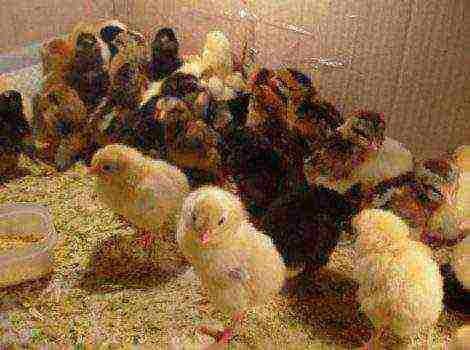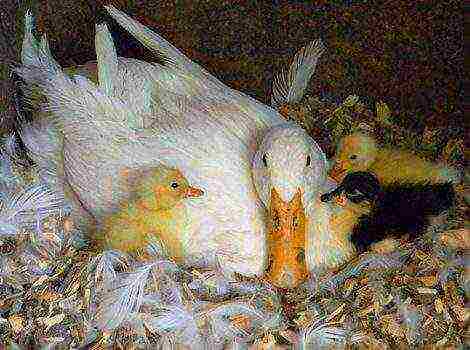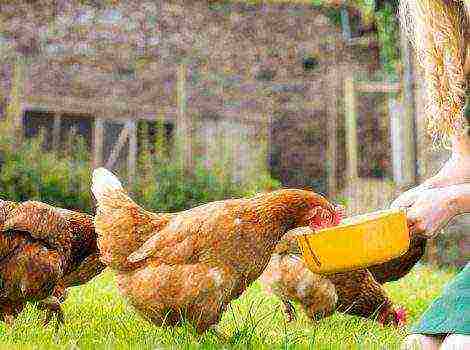Content
- 1 Description of the breed of chickens faverol
- 1.1 Exterior of the breed: how to distinguish between hens, roosters and chickens
- 1.2 Varieties: salmon, blue, Colombian
- 1.3 Description of production characteristics
- 1.4 Conditions of detention
- 1.5 Chicken coop
- 1.6 Breeding chickens of this breed
- 1.7 Feeding
- 1.8 Diseases
- 1.9 Features and advantages of the breed
- 1.10 Reviews of the faverol chicken breed
Description of the breed of chickens faverol
In the 18th century in France, in the town of Faverolle, a breed of chicken was bred, the meat of which was intended for the preparation of refined broths. Three hundred years of selection have added external charm and egg production to the chickens.
In a number of countries, faveroli are bred exclusively for exhibitions. But beauty is not their main advantage.
Exterior of the breed: how to distinguish between hens, roosters and chickens
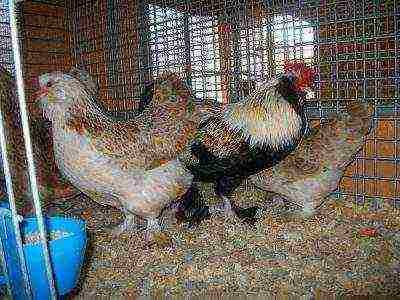 Faverol was bred on the basis of the Gudan, Brama, Cochinchin and Silver Dorking breeds.
Faverol was bred on the basis of the Gudan, Brama, Cochinchin and Silver Dorking breeds.
On the left in the photo, you can see a rooster and a chicken faverol.
In the poultry yard, chickens stand out for their harmonious constitution, characteristic plumage, five-toed paws.
Description of the breed of chickens faverol:
- Head slightly flattened flat shape, small.
- Powerful beak, short, white, light yellow or pink colors.
- The simple type is medium. Erect, leafy, low. The high prongs are evenly cut.
- The neck is tight, of medium length with a lush mane that extends to the back. Faverolei is distinguished by a characteristic neck collar, some feathers are oriented horizontally, others look up towards the back of the head.
- Red-orange eyes, medium size.
- The face is pubescent, red. Red lobes are feathered with bucks, a beard located under the beak. Earrings underdeveloped.
- The body is slightly elongated, trapezoidal, set horizontally, with a massive chest and well-developed muscles. The back is rather long. It turns into a strong, dense loin with rich integumentary plumage.
- The belly of the faveroli is deep. Chickens are more squat, heavy constitution.
- The tail is raised. The tail feathers are short. Roosters have short, curved braids. Chickens have a roof-like tail.
- Wings snug fit, set high on the torso.
- Legs with luxuriantly feathered short tibiae, without “hawk-like” tuft, well developed. Metatarsus white, of medium length. A distinctive feature of faverol chickens is the fifth finger, which is located above the hind toe, with a clearly separated long claw pointing upwards. The fourth finger is placed horizontally.
- Plumage loose, lush, soft. Abundant plumage helps faveroli during the winter season. Small feather "pillows" are noticeable.
- The skeleton is thin... The skin of all varieties of faveroli is creamy white.
- Chicks hatch with yellow, yellowish-white down. You have to wait to know how to tell the sex of the chicks. Sex differences they appear two months after birth, in cockerels, tanks and a beard are formed, feathers at the ends of the wings of cockerels are darker than in chickens.
- Coloration varied. Salmon and Colombian (silver) colors are considered traditional.
Varieties: salmon, blue, Colombian
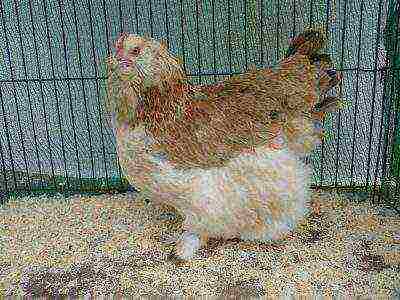 In the breed of chickens, the salmon faverol (lakhshuner), chickens and roosters are slightly different. Females have salmon, pink-red feathers with a white border; on the belly and chest, the shade is lighter.
In the breed of chickens, the salmon faverol (lakhshuner), chickens and roosters are slightly different. Females have salmon, pink-red feathers with a white border; on the belly and chest, the shade is lighter.
The nib is white. The tail and neck are dark brown with a reddish tint. Legs, belly, breast milk. On the right you can see a photo of this breed.
In roosters, the tail, chest, belly, bucks and beard, tibia, metatarsus are black, brown-red, interspersed with yellow and white. Ivory feathers on the back.On the white neck collar and flight feathers there is a black-green or brown-copper stripe with a mirror shine.
Not recommended for breeding:
- Roosters without red plumage on the first-order feathers and back, colored spots on the neck, excessive variegation of the abdomen, beard, interspersed with white on the belly and chest.
- Chickens are not salmon colored, with black feathers in the beard, with a white feather shaft.
The standards set forth birds with blue, blue-salmon, white, ermine, fawn, black, light birch (berken), splash, red-white, striped plumage.
Colombian (silver) faverole is silvery-white in the main color. Chickens and roosters are identical in color.
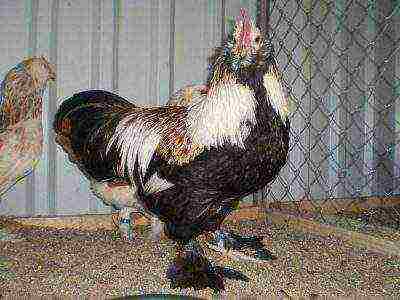 On the mane and tail along the feather shaft there are blue-black stripes with a green tint. The outline of the feather is clearly outlined with a white border. By standard, females 'tail feathers and males' large plaits may have the same border.
On the mane and tail along the feather shaft there are blue-black stripes with a green tint. The outline of the feather is clearly outlined with a white border. By standard, females 'tail feathers and males' large plaits may have the same border.
On the wings, the flight feathers are black with a white edging; on the folded wings, the black color is not noticeable. Feathers of the second order and down are white, without splashes.
Rejected:
- Birds with gray pattern.
- Birds with solid black color feathers on the mane, yellow feathers.
White — pure white coloration of chickens and roosters.
Blue faverole is the defining color of blue plumage of varying intensity. The outline of the pen is outlined.
Signs of uncleanness
- Poultry with underdeveloped muscles... Short, squat or too high, non-trapezoidal body, arched or convex back, sharp narrow numbness (back of the body).
- Individuals are withdrawn from the breeding herd without the fifth finger, with blue, yellow metatarsals, non-standard position in relation to each other of the fourth and fifth fingers, yellow beak, excessively prominent pillows in the upper tail area, large ridge, long tail.
- Unacceptable short and narrow neck, low-feathered bumps and beard, the presence of a "hawk clod", cuffs on the metatarsals, the lack of hairstyles in chickens.
Description of production characteristics
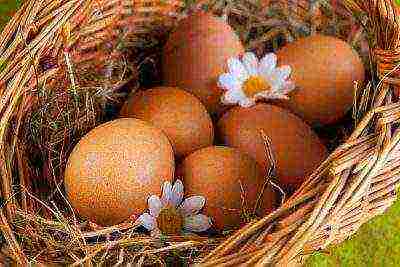 Faveroli belong to the general-use, with a bias towards the meat direction, early maturing breed.
Faveroli belong to the general-use, with a bias towards the meat direction, early maturing breed.
Chickens from two months quickly gain weight, they are suitable for slaughter by 4-4.5 months of age. The weight of males is 3-4 kg, chickens are 2.5-3.5 kg.
White, tender meat is appreciated for its fine fiber and juiciness. Gourmets prefer pasture-based fragrant poultry meat. Its taste is similar to pheasant meat.
Thin skin is easily plucked, there is no need to singe the carcass. The bones are thin and light.
Egg production is average. In the first year of egg production - 160-180 pieces per year, in the second - 130.
Egg mass 55-60 g. Usually a hen lays two eggs in three days. Strong shell of yellow, brown, pink color.
Faveroli begin to rush after reaching six months of age with a day length of at least 13 hours. They rush well in winter.
Temperament
Gullible, open character. They quickly tame, recognize the owner. Calm, phlegmatic, inclined to contemplation. They stay in one place for a long time, observing others.
They have a good appetite, therefore they are prone to obesity. They are lively with neighbors for walking, balanced.
Conditions of detention
Faverol chickens do not tolerate cages and aviaries well. Easily fattening birds need conditions for physical activity.
Walking
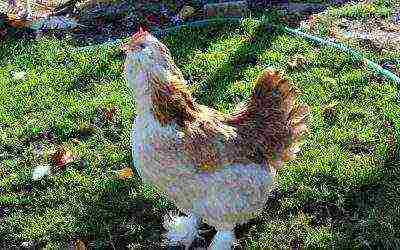
Free-range chickens are less likely to get sick, they have a high percentage of egg fertilization, since they have the opportunity to receive trace elements, vitamins, minerals from pasture.
Mistresses appreciate the faveroli for their delicacy, when searching for insects, they do not break the beds and flower beds.
They don't like to fly.There is no need to enclose the walk high.
Chicken coop
Faverolei is settled in a spacious chicken coop. In the hen house, dry bedding is made, the humidity of the air is monitored. Chickens do not tolerate high humidity.
Do not allow crowding. With a large number of birds in a small space, there is a risk of disease. The consumption of feed increases, the chickens trample it.
Hang up the feeders or make crossbars in the feeding troughs so that the chickens do not scatter feed.
In order to avoid fractures when falling from a height, round wide perches with a ladder for lifting are made.
Breeding chickens of this breed
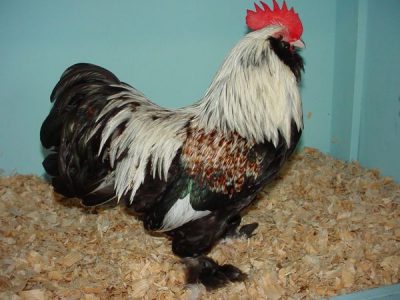 Pure breed chickens are rare. German and Hungarian breeding material has proven itself well. There are several domestic breed lines.
Pure breed chickens are rare. German and Hungarian breeding material has proven itself well. There are several domestic breed lines.
The cost of weekly chickens from 300 rubles, two-weekly from 350 rubles, hatching eggs from 600 rubles, half-year-old poultry from 5000 rubles.
The optimal time for hatching chicks is February. In the spring, the chicks can already be released for walking, and in the summer the chicks will begin to rush.
In order to avoid closely related crossing, leading to the degeneration of the breed, the appearance of defects and deformities in chickens, a decrease in productivity, they contain at least 5-6 females and a rooster of a different line. However, it is not recommended to keep more than 10-15 heads.
- Eggs for hatching chicks are taken from chickens one year old, stored at a temperature not exceeding + 10 ° С for no more than two weeks.
- Chicks are more often taken to incubator... Chickens are not very good brood hens.
- The incubator is kept at exactly + 37.6 ° C. A drop of even 1 / 10th of a degree leads to the appearance of twisted toes and legs in chickens.
- Hatching takes place amicably on day 22. Newborns are immediately planted on a warm, dry bed, maintain the room temperature + 38 °.
- During short daylight hours carry out additional lightingespecially in cloudy, dark weather.
Feeding
Adult birds
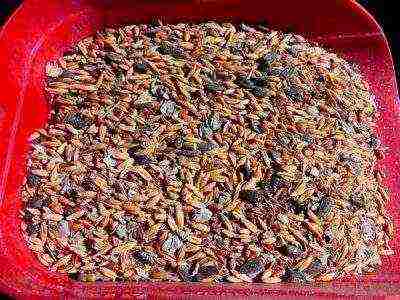 A balanced diet is required. Preference is given to dry feed, compound feed.
A balanced diet is required. Preference is given to dry feed, compound feed.
Wet mash stains the lush plumage of birds. Pecking out the stuck remains of chickens inflict injuries on each other, take on an untidy look.
In the summertime, 1/3 of the daily consumption is green mass, pasture. Of the herbs, legumes, grains, nettle, meadow clover, woodlice, dandelions, purslane, pig, alfalfa, peas, oats, and wheat are considered the most suitable.
After walking, the bird is fed with grain, compound feed.
The daily rate of compound feed, grain (corn, wheat, oats) per head is 150-155 g. At the onset of obesity, they put on a diet, reducing the feed to 80 g.
In winter and spring, the green mass is replaced with germinated wheat grains, pumpkin pulp, zucchini, carrots, steamed nettles, dried beet and carrot tops, spruce, pine and fir needles.
Vitamin supplements are required. With a low egg yield, oatmeal is added to the diet. In winter, wet food is warmed up.
With combined nutrition feed is given 3-4 times a day, alternating dry and wet mixtures.
Chickens: description, photo, video
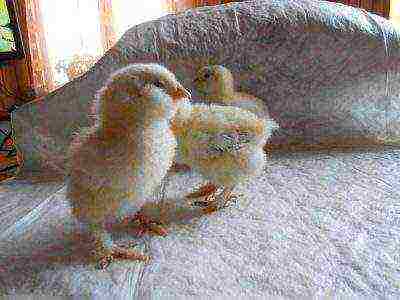 After hatching, the chickens are fed with chopped boiled eggs, cottage cheese, and corn porridge.
After hatching, the chickens are fed with chopped boiled eggs, cottage cheese, and corn porridge.
On the 11th day, they begin to give complete chicken feed.
Feeding scheme:
- 1-30 days 6-8 times, at regular intervals,
- 30-60 day -- 4 times,
- after 60 days - 3 times a day.
Diseases
Chickens are resistant to diseases, unpretentious. The main danger lies in the increased humidity of the chicken coop, litter. If the optimal keeping regimen is not observed, the bird becomes sick and dies.
Features and advantages of the breed
They are distinguished by their endurance, resistant to harsh climatic conditions.They quickly reach food maturity and egg production.
With good production characteristics, they have a beautiful appearance. Specific features - five-fingered, characteristic bumps, beard, neck collar.
Among the disadvantages, poultry farmers note a tendency to obesity., difficulties in acquiring and maintaining the purity of the breed.
Reviews of the faverol chicken breed
We bring to your attention a few reviews about this breed:
Faverolles ... My dream ... Just according to our climate, and excellent foragers, and meat, and beauties. They are all good for everyone. farmers' forum
I admire not only the beautiful flower garden of faveroli in my chicken coop, but also admire their meat in the kitchen and on the table. A 6 month old rooster roasts as fast as a young broiler. Delicate, juicy, and the meat of the faveroli has no competitors in taste.
farmers' forum
I am a faverole krill breed. My weight at six months is from 3.200 to 3.800, the weight of the gutted carcass is 2.200-2.600, the weight begins to gain well after 2 months, I would say that they shoot, by 4-4.5 months the carcass looks decent, round and appetizing. With age, meat does not get tougher and rougher. It is very convenient for me that the slaughter time stretches indefinitely, always the freshest, tender meat.
And one more moment, maybe ridiculous. Their carcasses are not hairy, you singe them more for the sake of form, Zagorskaya salmon is just a curly punk after plucking compared to the faverole. The skin of the chicken faverol is thinner and whiter than that of other breeds. And the carcass looks very attractive - soft pink. For us, faverol, like meat, is an undeniable favorite. farmers' forum
Originally bred as a meat table breed of fawerol chickens, thanks to many years of selection, it acquired a high egg production and decorative effect.
Despite the difficulties with the acquisition of breed material and its high cost, faverol chickens take up more and more space in the poultry houses of amateurs and farmers.
You can watch an interesting video about this breed:
